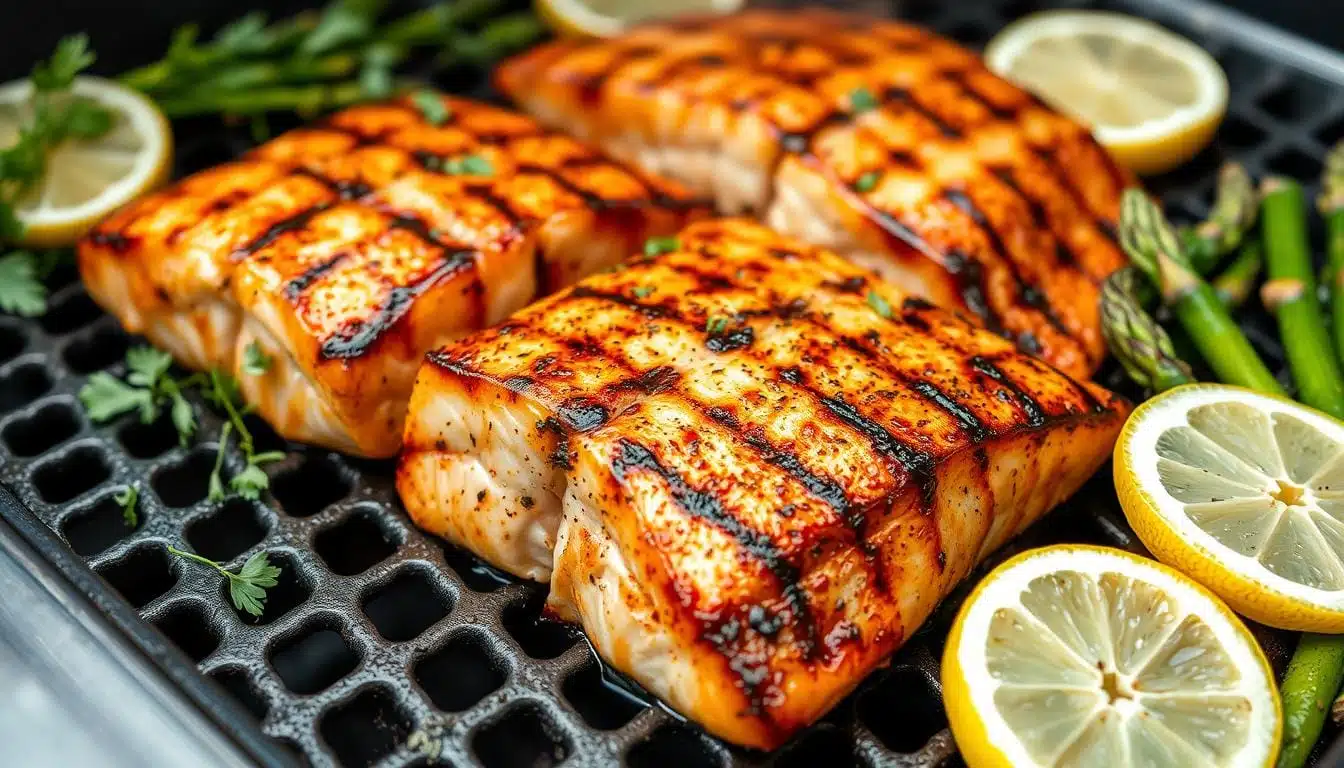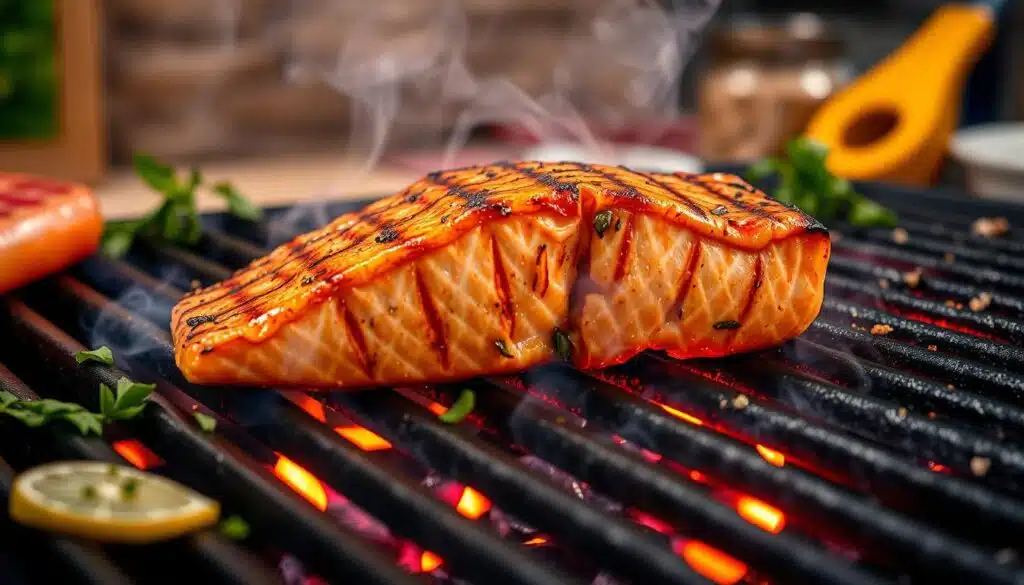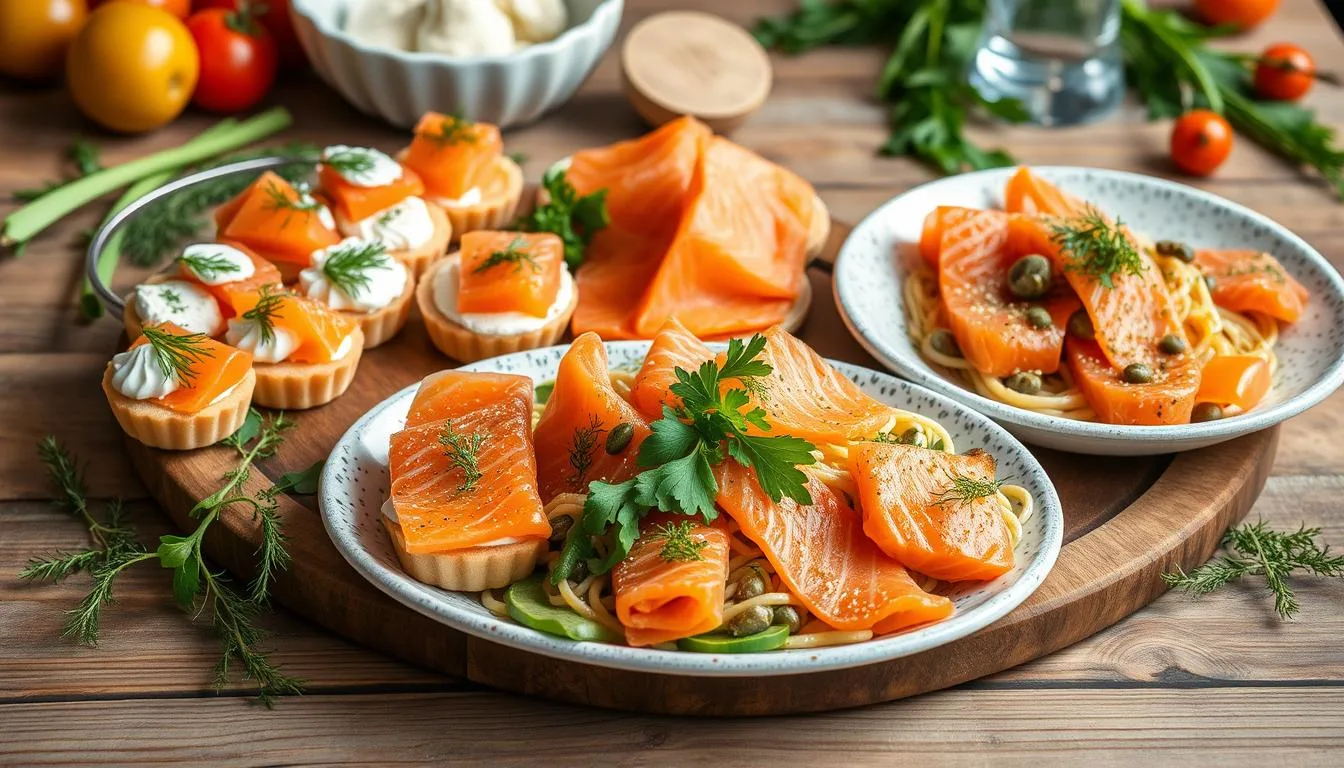what unit to flip salmon on the grill recipe?

“Cooking is all about people. Food is maybe the only universal thing that really has the power to bring everyone together.” – Guy Fieri
Grilling salmon can be a fun and rewarding experience. But flipping the fish on the grill can be tricky. This guide will show you how to make perfectly cooked, flaky grilled salmon recipe every time. You’ll learn about the right equipment, salmon grilling instructions, and salmon grilling times.
Table of Contents
Whether you’re an experienced griller or just starting out, this article has got you covered. You’ll learn how to flip salmon easily and make it moist and flavorful. Get ready to wow your friends and family with your new grilling skills!
Essential Tools and Equipment for Grilling Salmon
Grilling salmon to perfection needs the right tools. From special spatulas to thermometers, the right gear makes a big difference. Whether you’re experienced or new, knowing the essential tools can improve your grilling skills.
Types of Grilling Spatulas and Their Uses
The right spatula is key for flipping salmon on the grill. Here are some common spatulas and their uses:
- Wide-Bladed Spatula: Great for flipping and moving larger salmon pieces without breaking them.
- Fish Spatula: It has a thin, slotted blade for sliding under fish fillets, making it perfect for turning salmon.
- Grill Tongs: These versatile tongs help you grip and move salmon on the grill, giving you control over cooking.
Additional Grilling Accessories Needed
There are more accessories that can make grilling salmon better:
- Grill Brush: A good grill brush keeps your grates clean, ensuring your salmon cooks well.
- Meat Thermometer: A reliable thermometer helps you check the salmon’s internal temperature, preventing overcooking.
- Grill Baskets: These baskets are great for grilling small or delicate salmon pieces, keeping them from falling through the grates.
Choosing the Right Grill Surface
The grill surface you choose affects your salmon’s taste and texture. Think about the material, grate spacing, and heat distribution when picking the best surface:
| Grill Surface | Advantages | Considerations |
|---|---|---|
| Cast Iron Grates | Excellent heat retention and searing capabilities | Requires seasoning and maintenance to prevent sticking |
| Stainless Steel Grates | Durable, easy to clean, and corrosion-resistant | May not provide the same level of searing as cast iron |
| Porcelain-Enameled Grates | Smooth, non-stick surface, and even heat distribution | Potential for chipping or cracking over time |
Investing in the right tools and choosing the best grill surface can help you grill salmon perfectly every time. With the right equipment and techniques, you’ll master salmon grilling in no time.
Preparing Your Salmon for the Perfect Grill
Grilling salmon starts with preparation. Whether you’re marinating or seasoning, the prep is key. It makes the grilling experience enjoyable.
First, clean your salmon fillets well. Rinse them under cool water and dry with paper towels. This helps the seasoning stick better.
- For a classic salmon marinade, mix olive oil, lemon juice, garlic, and herbs and spices.
- Marinate the salmon for 30 minutes to 2 hours in the fridge. This adds great flavors.
Letting the salmon come to room temperature before grilling is crucial. It cooks evenly and prevents overcooking. Just take it out of the fridge 15-20 minutes before grilling.
| Salmon Marinade Ingredients | Quantity |
|---|---|
| Olive Oil | 1/4 cup |
| Lemon Juice | 2 tablespoons |
| Garlic, minced | 2 cloves |
| Fresh Dill, chopped | 2 tablespoons |
| Salt | 1 teaspoon |
| Black Pepper | 1/2 teaspoon |
Proper preparation is the first step to great grilled salmon. With the right marinade and temperature, you’re ready for success.
What Unit to Flip Salmon on the Grill Recipe
Grilling salmon to perfection is all about knowing the right cut sizes and flipping techniques. It’s important to check the thickness of your salmon fillets. This way, you can flip them at the right time for even cooking and a delicious taste.
Understanding Salmon Cut Sizes
Salmon comes in different cut sizes, each with its own cooking needs. The most common cuts include:
- Salmon fillets: These are the most popular cut, with a thickness ranging from 1/2 inch to 1 inch.
- Salmon steaks: Cut across the entire fish, salmon steaks typically measure between 3/4 inch to 1 1/2 inches in thickness.
- Salmon chunks or cubes: Smaller pieces of salmon, usually 1 to 2 inches in size, are perfect for skewers or foil packets.
Temperature Guidelines for Different Cuts
The internal temperature of your salmon is key for the perfect doneness. Here’s a general guide:
- Salmon fillets should reach an internal temperature of 145°F (63°C).
- Salmon steaks should be cooked to an internal temperature of 140°F (60°C).
- Salmon chunks or cubes should be cooked to an internal temperature of 135°F (57°C).
Timing Your Flips Based on Thickness
The thickness of your salmon cuts will tell you how often to flip them on the grill. Here’s a simple rule:
- Thin fillets (1/2 inch) may only need to be flipped once during cooking.
- Thicker fillets (1 inch) or steaks should be flipped every 2-3 minutes to ensure even cooking.
- Salmon chunks or cubes may need to be flipped more frequently, about every 1-2 minutes, to prevent burning.
By knowing the different salmon cut sizes, temperature guidelines, and flip timing, you can master the art of what unit to flip salmon on the grill recipe. This way, you’ll always get perfectly grilled salmon.
Mastering the Art of Salmon Marinade
Making the perfect salmon marinade can change the game when grilling fish. The right mix of flavors can make a simple salmon fillet into a masterpiece. You can go from bold to delicate with marinades.
When grilling salmon, the marinade is key. The right mix of ingredients adds depth of flavor that matches the salmon’s natural richness. Choose from tangy citrus or savory herbs, letting the salmon soak up the flavors before grilling.
Ideal Marinating Times
The marinating time greatly affects the result. Salmon should marinate for at least 30 minutes but no more than 2 hours. This lets the flavors soak in without ruining the fish’s texture.
| Marinating Time | Effect on Salmon |
|---|---|
| 30 minutes | Allows the marinade to lightly season the salmon, without overpowering the natural flavor. |
| 1-2 hours | Provides a more pronounced flavor profile, as the salmon has had time to fully absorb the marinade. |
| More than 2 hours | Can result in a mushy or compromised texture, as the acid in the marinade breaks down the fish’s structure. |
Knowing the best marinating times helps your salmon marinade enhance the fish’s natural qualities, not overpower them.
“The secret to a great salmon marinade lies in the balance of flavors and the patience to let the fish soak up all the goodness.”
Marinade Ingredients to Enhance Flavor
- Citrus (lemon, lime, orange juice)
- Herbs (dill, rosemary, thyme)
- Aromatics (garlic, ginger, shallots)
- Sweeteners (honey, maple syrup, brown sugar)
- Acids (vinegar, wine, soy sauce)
Choosing the right salmon marinade ingredients can elevate grilled salmon. Try different mixes to find what you like best.
Perfect Temperature Control for Grilled Salmon
Getting the right temperature when grilling salmon is key to a tasty meal. The right temperature makes the salmon moist and flavorful. Let’s look at how to manage the temperature for your grilled salmon.
Direct vs Indirect Heat Methods
Where you place your salmon on the grill affects the cooking. Direct heat is great for searing and getting a crispy skin. Indirect heat is better for even cooking, so the salmon cooks inside without burning outside.
Temperature Zones on Your Grill
- Hot Zone: The area directly over the heat source, perfect for searing and quick cooking.
- Medium Zone: The area just to the side of the hot zone, where the heat is slightly less intense, allowing for more gradual cooking.
- Cool Zone: The area farthest from the heat source, useful for keeping cooked salmon warm or finishing the cooking process.
Knowing your grill’s temperature zones helps you place your salmon right. This ensures it cooks evenly and reaches the perfect doneness.
Using a Meat Thermometer Properly
A good meat thermometer is crucial for checking your salmon’s internal temperature. Stick the thermometer into the thickest part of the fillet, away from bone or fat. For medium-rare, aim for 125°F to 130°F. For medium, it’s 135°F to 140°F. Checking the temperature often prevents overcooking and ensures your salmon is just right.
| Salmon Doneness | Internal Temperature |
|---|---|
| Rare | 120°F – 125°F |
| Medium-Rare | 125°F – 130°F |
| Medium | 135°F – 140°F |
| Medium-Well | 145°F – 150°F |
| Well-Done | 155°F and above |
By understanding your grill’s heat zones and using a meat thermometer, you can control the temperature of your grilled salmon. This ensures a delicious and satisfying meal every time.
Step-by-Step Flipping Technique for Grilled Salmon
Flipping salmon on the grill is key to getting it perfectly cooked. It doesn’t matter if you’re new to grilling or have been doing it for years. The right technique makes all the difference. Here, we’ll show you how to flip salmon on the grill for a dish that looks and tastes like it came from a restaurant.
First, you need the right tools. A good fish spatula or turner is essential. It’s thin and wide, so you can flip the salmon gently without breaking it. Also, having strong tongs can help you move the salmon around on the grill.
- Preheat your grill to medium-high heat, making sure it’s even across the grate.
- Place the salmon fillets on the grill, skin-side down if they have skin.
- Cook the salmon for 3-4 minutes, depending on its thickness, before flipping.
- When it’s time to flip, slide the spatula or turner under the salmon. Lift and flip it gently, making sure it stays whole.
- Cook the other side for another 3-4 minutes, until it’s cooked to your liking.
- Use the spatula or tongs to move the grilled salmon to a plate or platter.
Flipping salmon successfully means going slow and gentle. Don’t press too hard, as this can break the fish. With practice, you’ll get better at flipping salmon and impress your guests with perfectly grilled salmon every time.

| Salmon Fillet Thickness | Cooking Time Before Flipping | Total Cooking Time |
|---|---|---|
| 1/2 inch | 3 minutes | 6-8 minutes |
| 3/4 inch | 4 minutes | 8-10 minutes |
| 1 inch | 5 minutes | 10-12 minutes |
By following these salmon grilling instructions and using the right tools, you’ll get perfectly grilled salmon every time. Remember, be gentle, patient, and watch the salmon closely as it cooks. This will help you achieve a delicious and beautiful dish.
Common Mistakes to Avoid When Grilling Salmon
Grilling salmon can be a delightful culinary experience, but it’s not without its challenges. To ensure your salmon grilling endeavors are a resounding success, it’s crucial to be aware of the common pitfalls and how to navigate them. From preventing sticking issues to managing flare-ups effectively, this section will equip you with the knowledge to become a salmon grilling master.
Prevention of Sticking Issues
One of the most frustrating experiences when grilling salmon is having the delicate fillets stick to the grill grates. To prevent this, start by ensuring your grill grates are properly oiled and preheated to the right temperature. Additionally, consider using a fish grilling basket or cedar planks to create a barrier between the salmon and the grates, minimizing the risk of sticking.
Avoiding Overcooking and Dryness
Salmon is a relatively delicate fish, and it’s all too easy to end up with dry, overcooked fillets. To combat this, pay close attention to the internal temperature of your salmon, using a reliable meat thermometer to ensure it’s cooked to perfection. Additionally, consider basting your salmon with a flavorful marinade or sauce to help retain moisture and juiciness.
Managing Flare-ups Effectively
Grilling salmon can sometimes lead to unexpected flare-ups, which can result in charred or unevenly cooked fillets. To manage these flare-ups, keep a spray bottle of water nearby to quickly extinguish any sudden bursts of flame. Additionally, consider using a grill with a lid, as this can help contain and control any flare-ups that may occur.
By being mindful of these common mistakes and implementing the appropriate techniques, you can elevate your salmon grilling skills to new heights, ensuring a consistently delicious and perfectly cooked result every time.
| Common Grilling Mistakes | Solutions |
|---|---|
| Sticking salmon to the grill grates |
|
| Overcooking and drying out the salmon |
|
| Managing flare-ups on the grill |
|
By staying vigilant and implementing these strategies, you can navigate the common challenges of grilling salmon and elevate your skills to new heights, ensuring a consistently delicious and perfectly cooked result every time.
Advanced Tips for Cedar Plank Grilling
Grilling salmon on a cedar plank adds a smoky aroma and unique flavor. To make your salmon on cedar plank grill even better, try these advanced tips:
- Soak the cedar planks well: Put them in water for at least 30 minutes, or up to 2 hours. This keeps the wood from burning and drying out.
- Try different woods: Use apple, cherry, or oak to get unique flavors. Each wood adds its own taste to the salmon grilling tips.
- Get the plank ready: Brush the soaked plank with oil or butter before adding the salmon. This stops the fish from sticking to the wood.
- Watch cooking times: Salmon on cedar planks cooks faster than on grates. Keep an eye on the temperature and adjust cooking times as needed.
Using these advanced methods will make your salmon on cedar plank grill even more special. You’ll impress your guests with the rich, smoky flavors cedar planks add to salmon.

“The aroma of the cedar plank and the smoky flavor it imparts on the salmon is simply unbeatable. It’s a game-changer for any grilling enthusiast.”
Conclusion
In this guide, we’ve uncovered the secrets to grilling salmon to perfection. We’ve talked about choosing the right tools and mastering temperature control. The key to delicious grilled salmon is in the details.
Flipping the salmon right is crucial. Use a spatula gently to avoid tearing the fish. Check the internal temperature and time your flips based on the fish’s thickness. This way, you can get your salmon just right, whether you like it rare, medium, or well-done.
Try different marinades and grilling methods, like using a cedar plank, to explore new flavors. With practice and focus on the basics, you’ll grill grilled salmon recipe that wows everyone. Remember, the salmon grilling instructions here are a good start. But don’t hesitate to add your own twist to your grilled salmon dishes.





